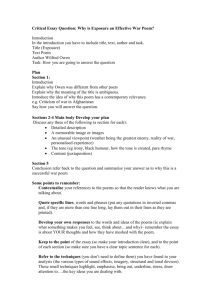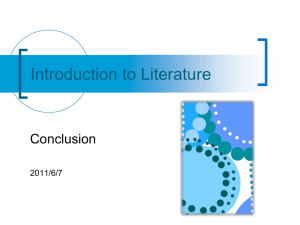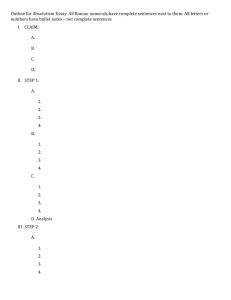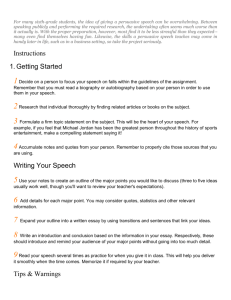compare and contrast essay poetry updated1
advertisement
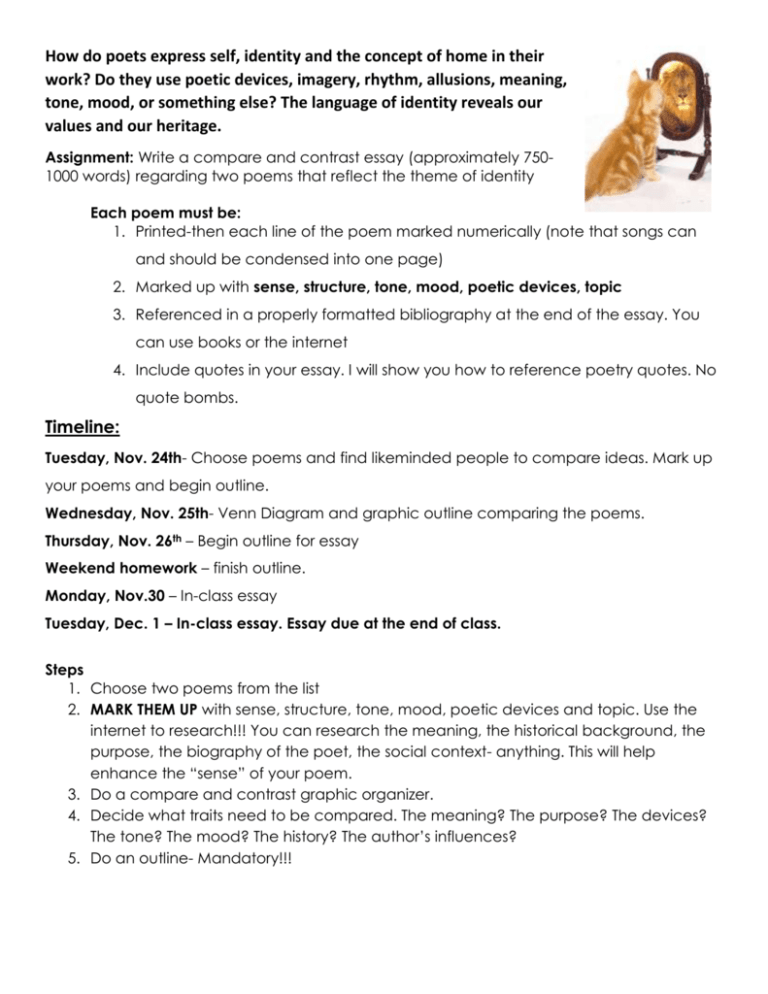
How do poets express self, identity and the concept of home in their work? Do they use poetic devices, imagery, rhythm, allusions, meaning, tone, mood, or something else? The language of identity reveals our values and our heritage. Assignment: Write a compare and contrast essay (approximately 7501000 words) regarding two poems that reflect the theme of identity Each poem must be: 1. Printed-then each line of the poem marked numerically (note that songs can and should be condensed into one page) 2. Marked up with sense, structure, tone, mood, poetic devices, topic 3. Referenced in a properly formatted bibliography at the end of the essay. You can use books or the internet 4. Include quotes in your essay. I will show you how to reference poetry quotes. No quote bombs. Timeline: Tuesday, Nov. 24th- Choose poems and find likeminded people to compare ideas. Mark up your poems and begin outline. Wednesday, Nov. 25th- Venn Diagram and graphic outline comparing the poems. Thursday, Nov. 26th – Begin outline for essay Weekend homework – finish outline. Monday, Nov.30 – In-class essay Tuesday, Dec. 1 – In-class essay. Essay due at the end of class. Steps 1. Choose two poems from the list 2. MARK THEM UP with sense, structure, tone, mood, poetic devices and topic. Use the internet to research!!! You can research the meaning, the historical background, the purpose, the biography of the poet, the social context- anything. This will help enhance the “sense” of your poem. 3. Do a compare and contrast graphic organizer. 4. Decide what traits need to be compared. The meaning? The purpose? The devices? The tone? The mood? The history? The author’s influences? 5. Do an outline- Mandatory!!! The African American Identity The Negro Speaks of Rivers- Langston Hughes Heritage- by Gwendolyn Bennett The Aboriginal Identity Identity Crisis- Gary Gottriedson My Heart Soars- Chief Dan George Always Told I Was A White Girl- by Tara Shannon Geographic identity Empire State of MindJayZ We Are More- Shane Koyasan Canadians- Mariam Waddington The Town- Macklemore Sexual Identity Tattoos- anonymous Same Love- Macklemore We Exist- Arcade Fire Poems about war by Wilfred Owen Live Life! O’ Me, O’Life by Walt Whitman Anthem for Doomed Youth Dulce et Decorum Lose Yourself- Eminem Possible websites to use: www.rapgenius.com http://www.poetryfoundation.org/ http://www.sparknotes.com/ http://www.poetryinvoice.com/ http://www.shmoop.com/ http://www.poets.org/ Follow these simple rules when quoting and citing poetry. 1) When you quote exact words, phrases, or lines from poems, set the quotations off with quotation marks and cite the line from which the textual material comes in parentheses at the end of the sentence containing it. Punctuate your sentence — that is, put your punctuation mark outside the end parenthesis. Ex.: According to the poem, “tender is the night” (35). 2) When you quote consecutive lines of poetry (lines that follow each other in the poem), use a virgule (/) to indicate where the lines “break” (are separated) in the poem. Then, in your parenthetical citation, list the first and last line quoted, separating them with a hyphen (dash). Ex.: According to the poem, “tender is the night, / And haply the Queen-Moon is on her throne, / Cluster’d around by all her starry Fays” (35-37). 3) When you quote four or more consecutive lines of poetry, use “long quotation” or “blockquote” formatting. Introduce the quotation with a short signal phrase; begin the quotation on the following line; indent the quotation twice; double space; punctuate exactly as in the text; cite lines parenthetically at the very end, outside the final punctuation. Do not punctuate the parenthetical citation. Ex.: The poem describes the night thus: … tender is the night, And haply the Queen-Moon is on her throne, Cluster’d around by all her starry Fays; But here there is no light … (35-38) 4) When you use quoted material from multiple lines but do not quote those lines consecutively, put a comma between the line numbers in your parenthetical citation and make sure the order of the line numbers in the parentheses corresponds to the order of the quoted material in the sentence. Ex.: The speaker tells us that, “tender is the night”; however, “here there is no light” (35, 38). 5) Do everything else as you would if you were quoting prose. Use ellipses (three dots) to show where you have removed words (ex. “on the … wings of Poesy” (33).). Use brackets to show where you have made minor adjustments to grammar (ex. The speaker states that “Darkling [he listens]” (51).). 6) Remember that as a writer you get to decide where to begin and end quoting the text: cut off quotations before awkward, unnecessary punctuation marks. Ex.: The poem states that, “haply the Queen-Moon is on her throne” (36). NOT: The poem states that, “haply the Queen-Moon is on her throne,” (36). 7) Always proofread quotations: double-check that your quotations are accurate and that you have not made any changes to the text in transcribing it into your paper. Compare and Contrast Essay for Poetry with Quotes Rubric 10 /9 Poetry Mark-up 8.5/8/7.5 All components are complete on both poems: sense, structure, tone, mood, topic and poetic devices Some components are complete: sense, structure, tone, mood, topic and poetic devices Some components are complete: sense, structure, tone, mood, topic and poetic devices. Could use more analysis Lines are numbered Lines are numbered Could use much more analysis OR some may be wrong Too many errors OR not enough evidence of thought Lines may or may not be numbered Lines may or may not be numbered States how poem reflects identity but may be confusing or basic. Supporting reasons may or may not be previewed. Thesis is not easily understood with little or no reference to the question. Strongly and clearly states the themes of identity. Previews the supporting reasons. Creative and insightful Conclusion is strong. Supporting Details (quotes and evidence from poems) Provides strong details, reasons and/or examples in support of the thesis. Clearly states a how this poem(s) reflects identity. Previews the supporting reasons. Intro may be basic. Conclusion wraps up argument but could be stronger. Provides little or no support of the opinion. Argument is intelligent. Understands the big ideas. Argument is correct but could be more mature or insightful. You may have missed some key ideas Argument is simple but correct. Could be more mature or insightful. Quotes are integrated seamlessly. Formatting is flawless Quotes are integrated but could be integrated smoother Quotes could be integrated better. Some quote bombs Formatting may or may not be flawless but obvious effort is made to try Formatting needs to be improved Sentences and paragraphs are complete, well written and varied. Sentences are varied and complex. Paragraph structure is generally correct. Sentences are sometimes varied and complex. Paragraph structure is generally correct. Insightful, intelligent argument about identity. Bombs and Formatting Format/ Organization Essay is organized regardless of essay type Mechanics and Grammar Intro and/or conclusion is weak or absent Provides some reasons and/or example in support of the thesis. Evidence may be weak or not match argument. A mature understanding of the subject. Use of Quotes Intro and/or conclusion does not wrap up thesis. Provides details, reasons and/or examples in support of the thesis. Evidence fits to the argument. May be slightly irrelevant to thesis or weak Quotes are very relevant and strong Argument 6/5.5/5 All components are complete and extensive: sense, structure, tone, mood, topic and poetic devices Thinking is obvious Opening Statement and Conclusion 7/6.5 There are no errors in grammar, spelling or mechanics Essay is organized regardless of essay type Few errors in grammar, spelling or mechanics Essay may not be organized as well as it should Support is weak or irrelevant. Little or no evidence of sentence or paragraph structure. Essay could be organized better. Some errors in grammar, spelling and mechanics Many errors in grammar, spelling and mechanics Needs to be proofread and edited. Needs to be proofread and edited.

